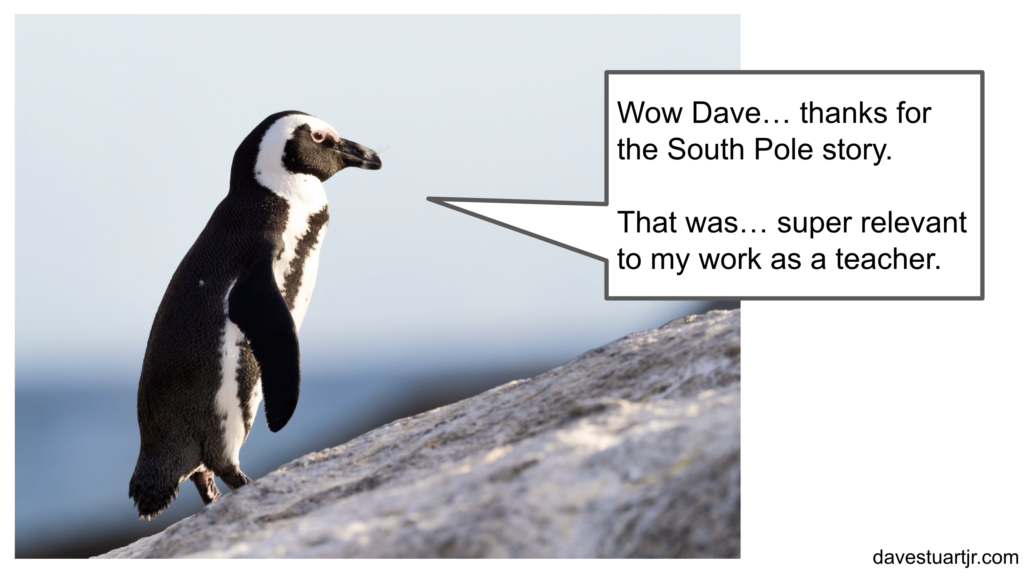During a five-year period in the 2010s, researcher Morten Hansen conducted one of the most comprehensive surveys of worker performance ever. He found 5,000 managers and employees, from all types of professions, and he analyzed their work habits, tracked how many hours they worked each week, and followed their performance.
The highest performers, it turned out, weren't the ones who worked the most hours — a few years ago, I wrote about this GREAT news in “There's Only So Much Juice in an Orange.”
But what I didn't discuss in that post is that, in lieu of working insane hours, the high performers tended to “do less, then obsess.” They weren't trying to be excellent at everything; they were masters at the arts of focusing and satisficing. While most folks look at life through a wide-angle lens, these people seemed to do it through a toilet paper tube — and boy, did it pay off.
In one story in the book, Hansen describes the epic race to the South Pole in 1911, in which two teams raced to be the world's first people to the planet's southernmost point. There were two teams:
- Robert Scott's, which had superior resources (a larger ship, three times the men, twice the budget, five forms of transportation); and
- Roald Amundsen's, which had inferior resources (smaller ship, fewer men, smaller budget, only one form of transportation).
The race ended up a blowout — Amundsen's team, with his small team of explorers and sled dogs, reached the Pole a month before Scott's. This was a bit of a shock — after all, Scott's team had dogs, motor sledges, Siberian ponies, skis, and man-hauling methods for moving through the harsh terrain. Amundsen had only dogs!
But Amundsen didn't just have dogs — he had been obsessing over them for years.
Here's Hansen:
Amundsen succeeded… because he concentrated only on dogs and eschewed backup options. During his three-year trip through the Northwest Passage, he had spent two winters apprenticing with the Inuits who had mastered dog sledging. Running a span of dogs is hard. They are unruly animals and sometimes drop down in the snow and refuse to work. Amundsen learned from the natives how to urge dogs to run, how to drive sledges, how to pace himself. He also obsessed over obtaining superior dogs. His research suggested that Greenlander dogs handled polar travel better than Siberian huskies. … “As far as dogs are concerned, it is absolutely essential that I obtain the very best it is conceivable to obtain.” … When star dog driver Sverre Hassel declined [to join the team], Amundsen didn't look for the next best but kept pursing Hassel. [He] exerted all his charm and force of character to coax Hassel… to sail with him. In the end, Hassel, worn down by [Amundsen's] persistence, agreed.
Morten Hansen, Great at Work, p. 17 (paperback | audio)
Meanwhile, guess what our unfortunate friend Mr. Scott was doing? Driving himself crazy “arranging for five separate transportation methods.” The result? “He couldn't focus on any of them. Rather than venturing to Siberia to secure ponies, Scott sent his aide… but [his aide] didn't know about ponies–he was a dog expert. So Scott's team ended up with twenty ill-suited ponies, which slowed the team down on their journey to the pole.”

Right — so while you and I aren't picking between ponies and sled dogs, in our quest this year we've got a harder task than making it to the South Pole before freezing to death.
You and me? We're after the long-term flourishing of young people, specifically by teaching them to master disciplines and arts that they otherwise wouldn't. We do this not just for some students — we do this for each student, all of them, every name on the roster. Why?
Dunno. Just heroes, I guess?
But if you and I want to do this kind of work well, we've got to be like Amundsen. We've got to figure out what our sled dogs are and, while we're at work, become super obsessed about sled dogs. Maybe your dogs right now are earnest and amicable argument (video coming tomorrow over on the channel), or pop-up debate, or Matthew Johnsons' essay of the week, or the nine moves for teaching with texts, or helping students stretch better in Phys Ed.
Let's bring it home. Before you go, two practical questions to reflect on and apply what we've been chatting about today:
- What's your sled dog right now? What area (singular!) of your practice, if you were to obsess over it and it alone for the next three months, do you think would be likely to produce large downstream benefits to you and your students for years to come?
- What stuff can you let go of — or just do at a “good enough” level — for the next three months so that you've got time and space to obsess over your sled dogs? (Can't be running after Siberian ponies now, can we?)
All right — that's a wrap, colleague. Take care — next time, we'll chat about ELIMINATE.
Teaching right beside ya,
DSJR
Today's article focused on OBSESS, the third discipline we'll be examining in next month's Time Management Stewarding Our Lives Seminar. The waitlist is about to get exclusive emails from me about time management; if you want on, click here, scroll down, and sign up!

Leave a Reply